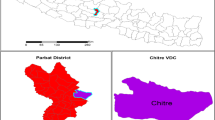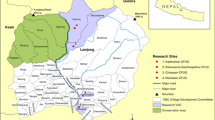Abstract
The research was designed to answer how households and local communities in rural Nepal are responding to the impacts of climate change. Using four villages as case study units, a mixed method approach was adopted in a multi-scaled process carried out at community, district and national levels. The research found that adaptation practices being adopted differ according to household well-being and are largely governed by access to education, information and resources within the community. Responses such as livelihood and income diversification, internal migration, share cropping, taking consumption loans, use of alternative energy and use of bio-pesticides were found to mostly vary according to well-being status of the interviewees. Development of adaptation plans, strategies and support mechanisms should take account of the different adaptation practices and needs of households. If such individual situations are not considered, adaptation responses may be ineffective or even be maladaptive and increase vulnerability. The research also found that the autonomous, unplanned and reactive nature of adaptation practices chosen by rural communities can contribute to further inequity and unequal power relations. The knowledge generated from this research contributes to understanding of how climate change contributes to vulnerability, but also how local practices and lack of an effective climate policy or response measures may magnify the effects of many existing drivers of vulnerability in terms of maladaptation and increasing social inequalities.



Similar content being viewed by others
References
Adger WN (2003) Social capital, collective action, and adaptation to climate change. Econ Geogr 79(4):387–404
Adger WN, Huq S, Brown K, Conway D, Hulme M (2003) Adaptation to climate change in the developing world. Prog in Dev Stud 3(3):179–195
Adger WN, Brooks N, Kelly M, Bentham G, Agnew M, Ereksen S (2004) New indicators of vulnerability and adaptive capacity. Technical Report 7. Norwich: Tyndall Centre for Climate Change Research. Retrieved from http://citeseerx.ist.psu.edu/viewdoc/download?doi=10.1.1.112.2300&rep=rep1&type=pdf
Agrawal A (2001) Common property institutions and sustainable governance of resources. World Dev 29(10):1649–1672
Agrawal A (2010) Local institutions and adaptation to climate change. In: Mearns R, Norton A (eds) Social dimensions of climate change: equity and vulnerability in a warming world. The World Bank, Washington DC
Alexander KS, Millar J, Lipscombe N (2010) Sustainable development in the uplands of Lao PDR. Sust Dev 18(1):62–70
Banerjee S, Gerlitz JY, Hoermann B (2011) Remittances: a key to adaptation? Perspectives from communities exposed to water stress in Himalayan region. International Centre for Integrated Mountain Development, Kathmandu
Barnett J (2001) Adapting to climate change in Pacific island countries: the problem of uncertainty. World Dev 29(6):977–993
Barnett BJ, Barrett CB, Skees JR (2008) Poverty traps and index-based risk transfer products. World Dev 36(10):1766–1785
Bartlett R, Bharati L, Pant, D, Hosterman H, McCornick P (2010) Climate change impacts and adaptation in Nepal. Colombo, Sri Lanka: International Water Management Institute. 35p. (IWMI Working Paper 139). https://doi.org/10.5337/2010.227
Bates B, Kundzewicz ZW, Wu S, Palutikof J (2008) Climate change and water. Intergovernmental Panel on Climate Change (IPCC), Cambridge
Brooks N, Grist N, Brown K (2009) Development futures in the context of climate change: challenging the present and learning from the past. Develop Pol Rev 27(6):741–765
Burton I (1997) Vulnerability and adaptive response in the context of climate and climate change. Clim Chang 36(1):185–196
CBS (2011) Nepal living standard survey 2010/11. Statistical Report, Vol. 2. Kathmandu: Central Bureau of Statistics, National Planning Commission Secretariat, Government of Nepal. Retrieved from http://siteresources.worldbank.org/INTLSMS/Resources/3358986-1181743055198/3877319-1329489437402/Statistical_Report_Vol2.pdf
Chapagain B, Gentle P (2015) Withdrawing from agrarian livelihoods: environmental emigration from Nepal. J Mountn Sci 12(1):1–13
Du M, Kawashima S, Yonemura S, Zhang X, Chen S (2004) Mutual influence between human activities and climate change in the Tibetan plateau during recent years. Glob and Planet Change 41(3–4):241–249
Fankhauser S, Smith JB, Tol RSJ (1999) Weathering climate change: some simple rules to guide adaptation decisions. Ecol Econ 30(1):67–78
Gentle P (2014) Equipping poor people for climate change: Local institutions and pro-poor adaptation for rural communities in Nepal. PhD Thesis, Charles Sturt University, Australia. Retrieved from https://researchoutput.csu.edu.au/ws/portalfiles/portal/9312475
Gentle P, Maraseni TN (2012) Climate change, poverty and livelihoods: adaptation practices by rural mountain communities in Nepal. Environ Sci Policy 21:24–34
Gentle P, Thwaites R, Race D, Alexander K (2014) Differential impacts of climate change on communities in the middle hills of Nepal. Nat Hazards 74(2):815–836
GoN (2010) National adaptation programme of action (NAPA). Ministry of Environment, Government of Nepal, Kathmandu
GoN (2012a) National population and housing census 2011 (National Report) (Vol. 01, NPHC 2011). Kathmandu: National Planning Commission, Central Bureau of Statistics, Government of Nepal
GoN (2012b) National population and housing census 2011 (Village Development Committee/Municipality) Volume 02 NPHC 2011. Kathmandu: National Planning Commission, Central Bureau of Statistics, Government of Nepal. Retrieved from http://cbs.gov.np/image/data/Population/VDC-Municipality%20in%20detail/VDC_Municipality.pdf
Hulme D, Shepherd A (2003) Conceptualizing chronic poverty. World Dev 31(3):403–424
IPCC (2001) Climate change 2001: impacts, adaptation and vulnerability. Cambridge University Press, Cambridge
IPCC (2007a) Assessment of adaptation practices, options, constraints and capacity. Climate change 2007: impacts, adaptation and vulnerability. Contribution of working group II to the fourth assessment report of the Intergovernmental Panel on Climate Change (IPCC). Cambridge University Press, Cambridge
IPCC (2007b) Impacts, vulnerabilities and adaptation in developing countries. Cambridge University Press, Cambridge
IPCC (2014) Climate change 2014: impacts, adaptation and vulnerability—summary for policy makers. Cambridge University Press, Cambridge
King N, Horrocks C (2010) Interviews in qualitative research. Sage Publications Ltd., London
Maru YT, Stafford Smith DM, Pinho PF, Dube OP (2014) A linked vulnerability and resilience framework for adaptation pathways in remote disadvantaged communities. Glob Environ Chang 28:337–350
Massey DS, Axinn WG, Ghimire DJ (2007) Environmental change and out-migration: evidence from Nepal. Population Studies Center Research Report 07-615. University of Michigan, Michigan
Mertz O, Halsnæs K, Olesen JE, Rasmussen K (2009) Adaptation to climate change in developing countries. Environ Mgt 43(5):743–752
Mosse D (1994) Authority, gender and knowledge: theoretical reflections on the practice of participatory rural appraisal. Dev and Chang 25(3):497–526
Nelson D, Adger N, Brown K (2007a) Resilience and adaptation to climate change: linkages and a new agenda. Ann Rev of Env Res 32:395–419
Nelson DR, Adger WN, Brown K (2007b) Adaptation to environmental change: contributions of a resilience framework. Ann Rev Env Res 32(1):395–419
O'Brien K, Eriksen S, Nygaard LP, Schjolden A (2007) Why different interpretations of vulnerability matter in climate change discourses. Clim Policy 7(1):73–88
Race D, Mathew S, Campbell M, Hampton K (2016) Understanding climate adaptation investments for communities living in desert Australia: experiences of indigenous communities. Clim Chang 139:461–475
Regmi BR, Bhandari D (2013) Climate change adaptation in Nepal: exploring ways to overcome the barriers. J Fort and Live 11(1):43–61
Regmi B, Suwal R, Shrestha G, Sharma GB, Thapa L, Manandhar S (2009) Community resilience in Nepal. Tiempo: Bull Climate Dev 73:7–10
Shishiso H (2009) Large scale migration and remittances: issues, challenges and opportunities. The World Bank and International Labour Organisation, Kathmandu
Smit B, Burton I, Klein RJT, Street R (1999) The science of adaptation: a framework for assessment. Mit and Adap Strat for Glob Chang 4(3):199–213
Smit B, Burton I, Klein RJT, Wandel J (2000) An anatomy of adaptation to climate change and variability. Clim Chang 45(1):223–251
Sohngen B, Mendelsohn R (1998) Valuing the impact of large-scale ecological change in a market: the effect of climate change on U.S. timber. Am Econ Rev 88(4):686–714
Springate-Baginski O, Blaikie PM (2007) Forests, people and power: the political ecology of reform in South Asia. Earthscan/James & James, London
Tacoli C (2009) Crisis or adaptation? Migration and climate change in a context of high mobility. Environ and Urban 21(2):513–525
Tanner T, Mitchell T (2008) Entrenchment or enhancement: could climate change adaptation help to reduce chronic poverty? IDS Bull 39(4):6–15
Tashakkori A, Teddlie C (2003) Handbook of mixed methods in social & behavioral research. Sage Publications, Inc., Thousand Oaks
Urothody A, Larsen H (2010) Measuring climate change vulnerability: a comparison of two indexes. Ban Janak 20(1):9–11
Williams AP, Seager R, Abatzoglou JT, Cook BI, Smerdon JE, Cook ER (2015) Contribution of anthropogenic warming to California drought during 2012–2014. Geophys Res Lett 42:6819–6828
World Bank (2011) Migration and remittances fact book 2011. The World Bank, Washington DC
Ziervogel G, Zermoglio F (2009) Climate change scenarios and the development of adaptation strategies in Africa: challenges and opportunities. Clim Res 40:133–146
Ziervogel G, Cartwright A, Tas A, Adejuwon J, Zermoglio F, Shale M et al (2008) Climate change and adaptation in African agriculture. Stockholm Environment Institute, Stockholm
Author information
Authors and Affiliations
Corresponding author
Rights and permissions
About this article
Cite this article
Gentle, P., Thwaites, R., Race, D. et al. Household and community responses to impacts of climate change in the rural hills of Nepal. Climatic Change 147, 267–282 (2018). https://doi.org/10.1007/s10584-017-2124-8
Received:
Accepted:
Published:
Issue Date:
DOI: https://doi.org/10.1007/s10584-017-2124-8




